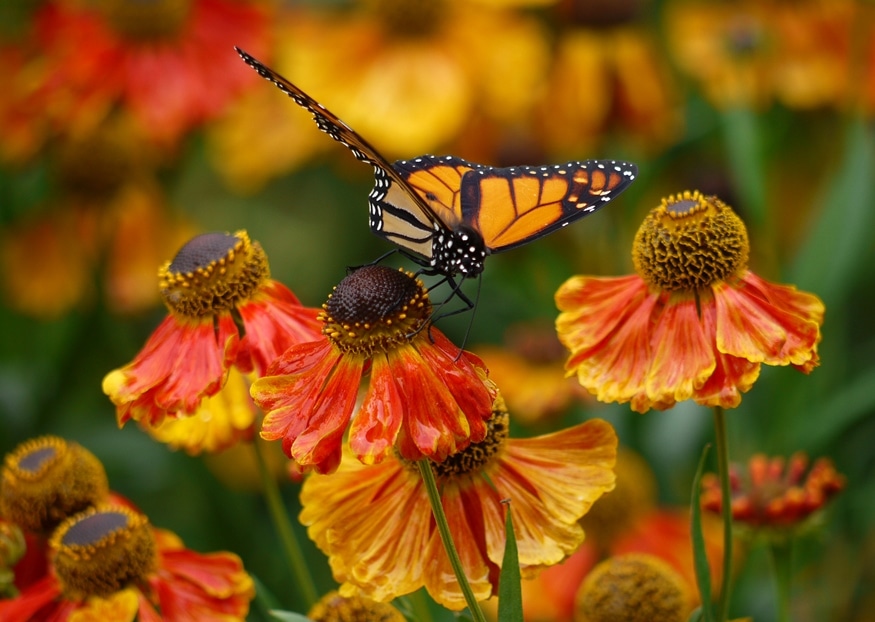All a flutter

The founder of the Moths and Butterflies of New Zealand Trust sets the golden rules for butterfly gardens in this new bi-monthly series. Words Jacqui Knight, Photo Sally Phillips.
It’s heartening to see the enthusiasm among gardeners on planting for pollinators. Bees, birds and butterflies need our help.
Did you know that our pollinator friends help produce over a third of our food? For example, milk comes from cows eating clover (among other things), which is pollinated by bees and other insects, and is also a host plant for our tiny little blue butterflies.
By creating a butterfly garden, you’re not just creating food for pollinators – you’ll also be blessed with these magical and colourful winged beauties gracing your garden. As one lady put it to me, they’re “flowers that fly”. They’ll brighten your day as well as your garden.
Unfortunately we don’t see as many butterflies as we once did. Catherine Hamilton’s beautiful book Butterflies of New Zealand, published in 1982, featured 23 species and two sub-species – where are they now?
When I founded the Moths and Butterflies of New Zealand Trust, I was prompted by people commenting that the butterflies of their youth were no longer seen. We should at least be seeing admirals (the yellow or the red), blues and possibly coppers, as well as our beautiful monarch – and the cabbage white, of course. Why not bring them all back to your garden?
The golden rules
1. Shelter – butterflies cannot fly in high winds.
You need to provide shelter from the wind, but not the sun (see point 2). If you know where your prevailing wind comes from, then you can plant shelter on that side. Best is a living wall of trees, shrubs and perennials. The wind will be filtered, not blocked, which would cause eddies and undercurrents and more disturbance in your garden.
Trees can be useful for your butterfly garden, providing nectar in the season. Two great examples are the scarlet bottlebrush (Callistemon citrinus) and the native lacebark houhere (Hoheria populnea). Some bottlebrushes will flower all year round but generally in the spring and early summer. Make sure you choose the scarlet one (more about that later). Lacebarks produce beautiful, white, perfumed flowers in summer or autumn, plus they are very quick-growing. The nectar of these two are popular with pollinators, including birds.
On the downwind side of your taller trees, plant shrubs and perennials to filter the wind. Echium, hebes and swan plants are great sources of nectar – and, of course, the swan plants are also food for the monarch caterpillars. Downwind of that, have your lower-growing perennials, ground covers and annuals. Mexican marigold, zinnias and cosmos are what you’ll find in my garden, plus the tropical milkweed. All of these are great for butterflies and produce more shelter. Muehlenbeckia and clovers as ground cover are hosts for our coppers and blue butterflies respectively.
2. Sunshine – being cold-blooded, butterflies need sunshine to warm up their wings.
They cannot fly until the sun has warmed them up sufficiently. The best garden will be set up on a north-facing slope to take advantage of the sun. On cooler days, butterflies may bask in the sunshine on a warm stone.
3. Flowers – adult butterflies survive on nectar.
As plants have been improved over the years to provide spectacular colours, more petals, variegated leaves, perfumes to delight or increased health, many have lost their nectar qualities. The flowers that offer nectar to our pollinators are often the original plants – the ones that you’ll find in an old-fashioned, long-established garden. This is probably why the aforementioned scarlet bottlebrush is preferred to other colourways.
Butterflies like a ‘landing pad’ of petals so daisy shapes are often preferred, but plants with flowers in pannicles (many small flowers in one cluster) are popular too. Beware of Buddleja davidii as it is a pest plant and should not be grown in a garden. You also want plants that flower continuously right throughout the season. Deadheading helps to stimulate more flowers as older blooms die.
In my garden this month
The butterflies are loving zinnias, cosmos and Mexican marigold, as well as perennials such as echinacea. Now I’m planning what will be flowering in the autumn: perennial asters and helenium are favourites. We have to keep our butterflies fed year-round!
Local matters
There are many good websites and books available to learn about gardening for butterflies, but the butterfly species and plants are often different to here in Aotearoa. As well as always being on the lookout for plants that are great for butterflies locally, the Moths and Butterflies of New Zealand Trust provides full information about what’s available and isn’t a pest plant here. Members also love our magazine and know that they are funding projects for the conservation of our butterflies and moths.
